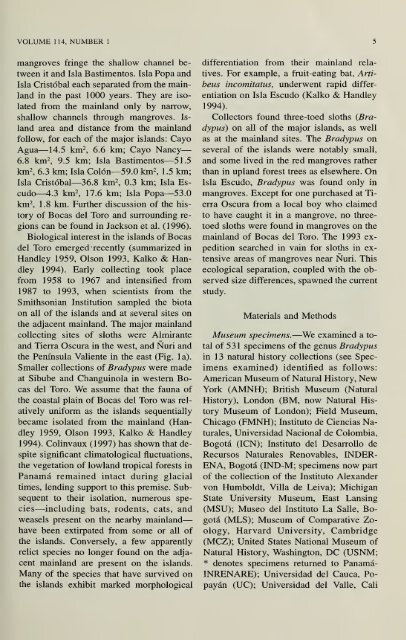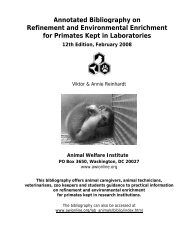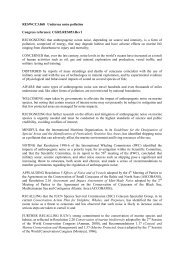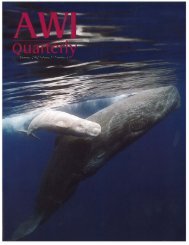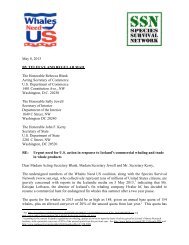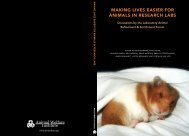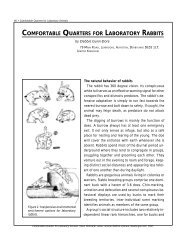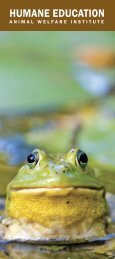EMERGENCY PETITION TO LIST THE PYGMY THREE-TOED SLOTH
EMERGENCY PETITION TO LIST THE PYGMY THREE-TOED SLOTH
EMERGENCY PETITION TO LIST THE PYGMY THREE-TOED SLOTH
Create successful ePaper yourself
Turn your PDF publications into a flip-book with our unique Google optimized e-Paper software.
—VOLUME 1 14, NUMBER 1mangroves fringe the shallow channel betweenit and Isla Bastimentos. Isla Popa andIsla Cristobal each separated from the mainlandin the past1000 years. They are isolatedfrom the mainland only by narrow,shallow channels through mangroves. Islandarea and distance from the mainlandfollow, for each of the major islands: CayoAgua— 14.5 km^, 6.6 km; Cayo Nancy6.8 km^, 9.5 km; Isla Bastimentos—51.5km2, 6.3 km; Isla Colon—59.0 km^, 1.5 km;Isla Cristobal—36.8 km^, 0.3 km; Isla Escudo—4.3km^, 17.6 km; Isla Popa—53.0km^, 1.8 km. Further discussion of the historyof Bocas del Toro and surrounding regionscan be found in Jackson et al. (1996).Biological interest in the islands of Bocasdel Toro emerged recently (summarized inHandley 1959, Olson 1993, Kalko & Handley1994). Early collecting took placefrom 1958 to 1967 and intensified from1987 to 1993, when scientists from theSmithsonian Institution sampled the biotaon all of the islands and at several sites onthe adjacent mainland. The major mainlandcollecting sites of sloths were Almiranteand Tierra Oscura in the west, and Nuri andthe Peninsula Valiente in the east (Fig.la).Smaller collections of Bradypus were madeat Sibube and Changuinola in western Bocasdel Toro. We assume that the fauna ofthe coastal plain of Bocas del Toro was relativelyuniform as the islands sequentiallybecame isolated from the mainland (Handley1959, Olson 1993, Kalko & Handley1994). Colinvaux (1997) has shown that despitesignificant climatological fluctuations,the vegetation of lowland tropical forests inPanama remained intact during glacialtimes, lending support to this premise. Subsequentto their isolation, numerous species—includingbats, rodents, cats, andweasels present on the nearby mainlandhave been extirpated from some or all ofthe islands. Conversely, a few apparentlyrelictspecies no longer found on the adjacentmainland are present on the islands.Many of the species that have survived onthe islands exhibit marked morphologicaldifferentiation from their mainland relatives.For example, a fruit-eating bat, Artibeusincomitatus, underwent rapid differentiationon Isla Escudo (Kalko & Handley1994).Collectors found three-toed sloths(Bradypus)on all of the major islands, as wellas at the mainland sites. The Bradypus onseveral of the islands were notably small,and some lived in the red mangroves ratherthan in upland forest trees as elsewhere. OnIsla Escudo, Bradypus was found only inmangroves. Except for one purchased at TierraOscura from a local boy who claimedto have caught it in a mangrove, no threetoedsloths were found in mangroves on themainland of Bocas del Toro. The 1993 expeditionsearched in vain for slothsin extensiveareas of mangroves near Nuri. Thisecological separation, coupled with the observedsize differences, spawned the currentstudy.Materials and MethodsMuseum specimens.—We examined a totalof 531 specimens of the genus Bradypusin 13 natural history collections (see Specimensexamined) identified as follows:American Museum of Natural History, NewYork (AMNH); British Museum (NaturalHistory), London (BM, now Natural HistoryMuseum of London); Field Museum,Chicago (FMNH); Instituto de Ciencias Naturales,Universidad Nacional de Colombia,Bogota (ICN); Instituto del Desarrollo deRecursos Naturales Renovables, INDER-ENA, Bogota (IND-M; specimens now partof the collection of the Instituto Alexandervon Humboldt, Villa de Leiva); MichiganState University Museum, East Lansing(MSU); Museo del Instituto La Salle, Bogota(MLS); Museum of Comparative Zoology,Harvard University, Cambridge(MCZ); United States National Museum ofNatural History, Washington, DC (USNM;* denotes specimens returned to Panama-INRENARE); Universidad del Cauca, Popayan(UC); Universidad del Valle, Call


